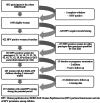Viral Load of Human Papillomavirus (HPV) During Pregnancy and Its Association With HPV Vertical Transmission
- PMID: 39912394
- PMCID: PMC11800320
- DOI: 10.1002/jmv.70221
Viral Load of Human Papillomavirus (HPV) During Pregnancy and Its Association With HPV Vertical Transmission
Abstract
Little is known on the dynamics of human papillomavirus (HPV) viral load during pregnancy and on the impact of viral load on HPV vertical transmission. We described viral loads for several genotypes during pregnancy and analyse its association with vertical transmission. Data were analysed from the HERITAGE study, a cohort of pregnant women recruited between 2010 and 2016 in three centres in Canada. Vaginal samples were collected at the first and third trimesters of pregnancy, placental samples were collected at birth, and conjunctival, oral, pharyngeal, and genital samples were collected in children at birth and 3 months were tested for HPV DNA and viral load by Linear Array essay. The association between viral load and vertical transmission was measured using logistic regression. Odd ratios (ORs) and their 95% Confidence intervals (CI) were adjusted for age of the mother. We included women in the cohort infected with the 13 most common genotypes during pregnancy (n = 287). A decrease in HPV viral load was observed during pregnancy (median difference between the third and first trimester of pregnancy = -0.005 copies/cell [p < 0.05]). Women with more than 2 HPV copies/cell (compared to those with ≤ 2 copies) at first trimester had a statistically significant higher risk of vertical transmission (adjusted OR = 6.41; 95% CI: 1.10-37.34 for any genotypes and OR = 17.17; 95% CI: 1.18-250.28 for HPV-16). Viral load values analysed continuously or categorized with different cut-offs showed comparable results. HPV viral load varied during pregnancy and was strongly associated with HPV vertical transmission. The results provide a better understanding of risk factors associated with vertical transmission.
Keywords: human papillomavirus (HPV); pregnancy; vertical transmission; viral load.
© 2025 The Author(s). Journal of Medical Virology published by Wiley Periodicals LLC.
Conflict of interest statement
F.C. has received funds to evaluate novel HPV detection tests through his institution, the research centre of the CHUM, from Becton‐Dickson and Roche Molecular systems. H.T. has received occasional lecture fees from Merck and unrestricted grants form ViiV Healthcare. All other co‐authors have no conflicts of interest.
Figures


References
-
- Franco E. L. and Trottier H., “Reassessing the Epidemiology of Human Papillomavirus Infection: Back to Basics,” Sexually Transmitted Diseases 35, no. 3 (2008): 283–285. - PubMed
-
- Schiffman M. and Castle P. E., “Human Papillomavirus: Epidemiology and Public Health,” Archives of Pathology and Laboratory Medicine 127, no. 8 (2003): 930–934. - PubMed
-
- Goggin FC P., Defay F., Lambert G., Mathieu‐Chartier S., Gilca V., and Sauvageau C.. Virus du papillome humain, Santé sexuelle et reproductive Rapport de recherche, d’étude ou d'analyse inspq.qc.ca: INSPQ 2016.
-
- Bruni L., Diaz M., Castellsagué X., Ferrer E., Bosch F. X., and de Sanjosé S., “Cervical Human Papillomavirus Prevalence in 5 Continents: Meta‐Analysis of 1 Million Women With Normal Cytological Findings,” Journal of Infectious Diseases 202, no. 12 (2010): 1789–1799. - PubMed
-
- Medeiros L. R., Ethur A. B. M., Hilgert J. B., et al., “Vertical Transmission of the Human Papillomavirus: A Systematic Quantitative Review,” Cadernos de Saúde Pública 21, no. 4 (2005): 1006–1015. - PubMed
MeSH terms
Substances
Grants and funding
LinkOut - more resources
Full Text Sources

